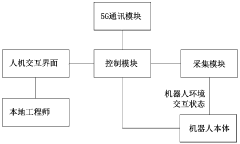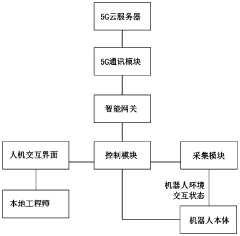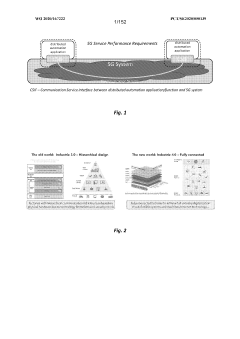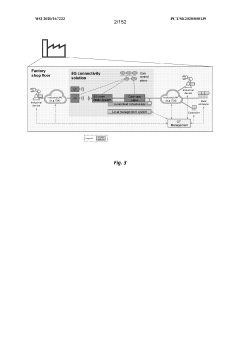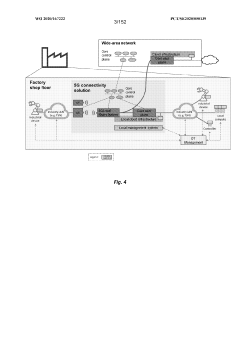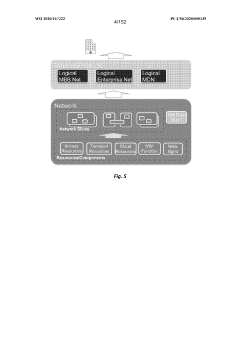Exploring the Integration of 5G UC with Advanced Robotics
JUL 18, 20259 MIN READ
Generate Your Research Report Instantly with AI Agent
Patsnap Eureka helps you evaluate technical feasibility & market potential.
5G UC and Robotics Evolution
The evolution of 5G UC (Ultra-Reliable Low-Latency Communication) and robotics has been marked by significant technological advancements and convergence. 5G UC, a key component of 5G technology, has been developing rapidly since its inception, focusing on providing ultra-low latency and high reliability for critical applications. This technology has progressed from theoretical concepts to practical implementations, with major milestones including the standardization of 5G UC specifications by 3GPP and successful field trials by leading telecom operators.
Concurrently, robotics has undergone a transformative journey, evolving from simple automated machines to sophisticated, AI-driven systems. Key developments in robotics include advancements in sensors, actuators, and control systems, enabling more precise and adaptable robotic operations. The integration of machine learning and computer vision has further enhanced the capabilities of robots, allowing them to perform complex tasks in dynamic environments.
The convergence of 5G UC and robotics represents a pivotal trend in technological evolution. This integration aims to leverage the ultra-low latency and high reliability of 5G UC to enhance robotic performance, particularly in scenarios requiring real-time control and decision-making. Early stages of this convergence focused on proof-of-concept demonstrations, showcasing the potential of 5G-enabled robots in controlled environments.
As the technologies matured, the focus shifted towards practical applications in various industries. Manufacturing saw the emergence of 5G-connected robotic arms capable of precise, synchronized movements. In healthcare, teleoperated surgical robots benefited from the reduced latency of 5G UC, enabling more accurate remote procedures. The logistics sector witnessed the development of autonomous mobile robots coordinated through 5G networks for efficient warehouse operations.
Recent advancements have pushed the boundaries further, with ongoing research into swarm robotics enabled by 5G UC. This involves coordinating large numbers of small robots to perform complex tasks collectively, leveraging the high-bandwidth and low-latency capabilities of 5G networks. Additionally, edge computing integration with 5G UC is enhancing the processing capabilities of robots, allowing for more sophisticated on-board decision-making while maintaining network connectivity.
Looking ahead, the evolution of 5G UC and robotics is expected to continue on a trajectory of increased integration and capability enhancement. Future developments may include the standardization of 5G UC protocols specifically tailored for robotic applications, further reducing latency and improving reliability. The advent of 6G technology on the horizon promises even greater possibilities for robot-to-robot and robot-to-infrastructure communication, potentially revolutionizing fields such as autonomous vehicles and smart cities.
Concurrently, robotics has undergone a transformative journey, evolving from simple automated machines to sophisticated, AI-driven systems. Key developments in robotics include advancements in sensors, actuators, and control systems, enabling more precise and adaptable robotic operations. The integration of machine learning and computer vision has further enhanced the capabilities of robots, allowing them to perform complex tasks in dynamic environments.
The convergence of 5G UC and robotics represents a pivotal trend in technological evolution. This integration aims to leverage the ultra-low latency and high reliability of 5G UC to enhance robotic performance, particularly in scenarios requiring real-time control and decision-making. Early stages of this convergence focused on proof-of-concept demonstrations, showcasing the potential of 5G-enabled robots in controlled environments.
As the technologies matured, the focus shifted towards practical applications in various industries. Manufacturing saw the emergence of 5G-connected robotic arms capable of precise, synchronized movements. In healthcare, teleoperated surgical robots benefited from the reduced latency of 5G UC, enabling more accurate remote procedures. The logistics sector witnessed the development of autonomous mobile robots coordinated through 5G networks for efficient warehouse operations.
Recent advancements have pushed the boundaries further, with ongoing research into swarm robotics enabled by 5G UC. This involves coordinating large numbers of small robots to perform complex tasks collectively, leveraging the high-bandwidth and low-latency capabilities of 5G networks. Additionally, edge computing integration with 5G UC is enhancing the processing capabilities of robots, allowing for more sophisticated on-board decision-making while maintaining network connectivity.
Looking ahead, the evolution of 5G UC and robotics is expected to continue on a trajectory of increased integration and capability enhancement. Future developments may include the standardization of 5G UC protocols specifically tailored for robotic applications, further reducing latency and improving reliability. The advent of 6G technology on the horizon promises even greater possibilities for robot-to-robot and robot-to-infrastructure communication, potentially revolutionizing fields such as autonomous vehicles and smart cities.
Market Demand Analysis
The integration of 5G UC (Ultra-Reliable Low-Latency Communication) with advanced robotics is poised to revolutionize various industries, driving significant market demand across multiple sectors. This convergence addresses critical challenges in robotics, such as real-time control, seamless connectivity, and enhanced autonomy, opening up new possibilities for industrial automation, healthcare, logistics, and smart manufacturing.
In the industrial sector, the demand for 5G UC-enabled robotics is particularly strong. Manufacturing companies are increasingly seeking solutions that can improve production efficiency, reduce downtime, and enhance flexibility. The ultra-low latency and high reliability of 5G UC allow for precise control of robotic systems, enabling complex tasks that were previously unfeasible. This capability is driving the adoption of collaborative robots (cobots) and autonomous mobile robots (AMRs) in factory settings.
The healthcare industry represents another significant market for 5G UC and advanced robotics integration. There is a growing need for remote surgical systems and telemedicine solutions, especially in underserved areas. The high bandwidth and low latency of 5G UC enable real-time transmission of high-quality video and haptic feedback, crucial for remote surgeries and diagnostics. This technology combination also supports the development of rehabilitation robots and exoskeletons, addressing the increasing demand for assistive technologies in aging populations.
Logistics and warehousing are experiencing a surge in demand for automated solutions, driven by the growth of e-commerce and the need for faster, more efficient supply chains. 5G UC-enabled robots can navigate complex warehouse environments with greater precision and coordination, optimizing inventory management and order fulfillment processes. The market for autonomous delivery robots, both for last-mile delivery and within large facilities, is expanding rapidly, fueled by the capabilities offered by this technological integration.
In the realm of smart cities and infrastructure, there is a growing market for robotic systems that can perform inspection, maintenance, and repair tasks in challenging environments. 5G UC provides the necessary connectivity for these robots to operate in areas that are difficult or dangerous for humans to access, such as underground tunnels, high-rise buildings, or disaster-stricken areas. This application is driving demand from municipal authorities and infrastructure management companies.
The agriculture sector is also showing increased interest in 5G UC-enabled robotics for precision farming applications. Farmers are looking for solutions that can improve crop monitoring, automate harvesting, and optimize resource usage. The combination of 5G UC and advanced robotics enables the deployment of swarms of agricultural drones and ground robots that can work in coordination to manage large areas of farmland efficiently.
As the technology matures and becomes more accessible, small and medium-sized enterprises (SMEs) are expected to drive significant market growth. These businesses are increasingly recognizing the potential of 5G UC and robotics to level the playing field with larger competitors, leading to a broader adoption across various industries and applications.
In the industrial sector, the demand for 5G UC-enabled robotics is particularly strong. Manufacturing companies are increasingly seeking solutions that can improve production efficiency, reduce downtime, and enhance flexibility. The ultra-low latency and high reliability of 5G UC allow for precise control of robotic systems, enabling complex tasks that were previously unfeasible. This capability is driving the adoption of collaborative robots (cobots) and autonomous mobile robots (AMRs) in factory settings.
The healthcare industry represents another significant market for 5G UC and advanced robotics integration. There is a growing need for remote surgical systems and telemedicine solutions, especially in underserved areas. The high bandwidth and low latency of 5G UC enable real-time transmission of high-quality video and haptic feedback, crucial for remote surgeries and diagnostics. This technology combination also supports the development of rehabilitation robots and exoskeletons, addressing the increasing demand for assistive technologies in aging populations.
Logistics and warehousing are experiencing a surge in demand for automated solutions, driven by the growth of e-commerce and the need for faster, more efficient supply chains. 5G UC-enabled robots can navigate complex warehouse environments with greater precision and coordination, optimizing inventory management and order fulfillment processes. The market for autonomous delivery robots, both for last-mile delivery and within large facilities, is expanding rapidly, fueled by the capabilities offered by this technological integration.
In the realm of smart cities and infrastructure, there is a growing market for robotic systems that can perform inspection, maintenance, and repair tasks in challenging environments. 5G UC provides the necessary connectivity for these robots to operate in areas that are difficult or dangerous for humans to access, such as underground tunnels, high-rise buildings, or disaster-stricken areas. This application is driving demand from municipal authorities and infrastructure management companies.
The agriculture sector is also showing increased interest in 5G UC-enabled robotics for precision farming applications. Farmers are looking for solutions that can improve crop monitoring, automate harvesting, and optimize resource usage. The combination of 5G UC and advanced robotics enables the deployment of swarms of agricultural drones and ground robots that can work in coordination to manage large areas of farmland efficiently.
As the technology matures and becomes more accessible, small and medium-sized enterprises (SMEs) are expected to drive significant market growth. These businesses are increasingly recognizing the potential of 5G UC and robotics to level the playing field with larger competitors, leading to a broader adoption across various industries and applications.
Technical Challenges
The integration of 5G UC (Ultra-Reliable Low-Latency Communication) with advanced robotics presents several significant technical challenges that need to be addressed for successful implementation. One of the primary hurdles is ensuring the ultra-low latency and high reliability required for real-time robotic control and operation. While 5G UC promises latencies as low as 1 millisecond, achieving this consistently in complex robotic applications remains a challenge, particularly in dynamic environments with varying network conditions.
Another critical challenge lies in the area of network slicing and resource allocation. Advanced robotics often require dedicated network resources to maintain optimal performance. Implementing effective network slicing techniques that can dynamically allocate resources based on the varying demands of robotic applications is a complex task that requires sophisticated algorithms and management systems.
The issue of seamless mobility and handover in 5G networks also poses a significant challenge for robotic applications. As robots move between different network cells or from indoor to outdoor environments, maintaining uninterrupted connectivity and consistent performance is crucial. Developing robust handover mechanisms that can support the high-speed, low-latency requirements of advanced robotics is an ongoing area of research and development.
Security and privacy concerns present another layer of technical challenges. The integration of 5G UC with robotics involves the transmission of sensitive data and control signals. Ensuring end-to-end security, protecting against cyber attacks, and maintaining data privacy while not compromising on performance and latency is a complex balancing act that requires advanced encryption and security protocols.
Edge computing integration is another area that presents technical hurdles. To fully leverage the potential of 5G UC in robotics, significant computing power needs to be moved closer to the network edge. This requires the development of efficient edge computing architectures that can handle the processing demands of advanced robotic applications while maintaining the low-latency promise of 5G UC.
Lastly, the challenge of interoperability and standardization cannot be overlooked. As the field of 5G-enabled robotics evolves, ensuring compatibility between different robotic systems, network equipment, and 5G infrastructure from various vendors is crucial. Developing and adhering to common standards and protocols is essential for widespread adoption and seamless integration of these technologies.
Another critical challenge lies in the area of network slicing and resource allocation. Advanced robotics often require dedicated network resources to maintain optimal performance. Implementing effective network slicing techniques that can dynamically allocate resources based on the varying demands of robotic applications is a complex task that requires sophisticated algorithms and management systems.
The issue of seamless mobility and handover in 5G networks also poses a significant challenge for robotic applications. As robots move between different network cells or from indoor to outdoor environments, maintaining uninterrupted connectivity and consistent performance is crucial. Developing robust handover mechanisms that can support the high-speed, low-latency requirements of advanced robotics is an ongoing area of research and development.
Security and privacy concerns present another layer of technical challenges. The integration of 5G UC with robotics involves the transmission of sensitive data and control signals. Ensuring end-to-end security, protecting against cyber attacks, and maintaining data privacy while not compromising on performance and latency is a complex balancing act that requires advanced encryption and security protocols.
Edge computing integration is another area that presents technical hurdles. To fully leverage the potential of 5G UC in robotics, significant computing power needs to be moved closer to the network edge. This requires the development of efficient edge computing architectures that can handle the processing demands of advanced robotic applications while maintaining the low-latency promise of 5G UC.
Lastly, the challenge of interoperability and standardization cannot be overlooked. As the field of 5G-enabled robotics evolves, ensuring compatibility between different robotic systems, network equipment, and 5G infrastructure from various vendors is crucial. Developing and adhering to common standards and protocols is essential for widespread adoption and seamless integration of these technologies.
Current Integration Solutions
01 Network architecture for URLLC in 5G
5G Ultra-Reliable Low-Latency Communication (URLLC) requires specific network architectures to meet stringent latency and reliability requirements. This includes optimized radio access networks, core network slicing, and edge computing solutions to reduce end-to-end latency and improve reliability for critical applications.- Network architecture for URLLC in 5G: 5G Ultra-Reliable Low-Latency Communication (URLLC) requires specific network architectures to meet stringent latency and reliability requirements. This includes optimized radio access networks, core network slicing, and edge computing solutions to reduce end-to-end latency and improve reliability for critical applications.
- Resource allocation and scheduling for URLLC: Efficient resource allocation and scheduling techniques are crucial for URLLC in 5G networks. This involves dynamic allocation of radio resources, prioritization of URLLC traffic, and advanced scheduling algorithms to ensure low latency and high reliability for time-critical communications.
- URLLC for industrial IoT and automation: 5G URLLC enables advanced industrial IoT applications and automation processes. This includes support for time-sensitive networking, precise synchronization, and deterministic communication for factory automation, remote control, and other mission-critical industrial use cases.
- Reliability enhancement techniques for URLLC: Various reliability enhancement techniques are employed in 5G URLLC, such as multi-connectivity, packet duplication, and advanced error correction methods. These techniques aim to improve the overall reliability of communication links, especially in challenging radio environments.
- Integration of URLLC with other 5G services: 5G networks need to support the coexistence and integration of URLLC with other services like enhanced Mobile Broadband (eMBB) and massive Machine-Type Communications (mMTC). This requires advanced radio resource management, network slicing, and quality of service mechanisms to ensure optimal performance across diverse use cases.
02 Resource allocation and scheduling for URLLC
Efficient resource allocation and scheduling techniques are crucial for URLLC in 5G networks. This involves dynamic allocation of radio resources, prioritization of URLLC traffic, and advanced scheduling algorithms to ensure low latency and high reliability for time-critical communications.Expand Specific Solutions03 URLLC for industrial IoT and automation
5G URLLC enables advanced industrial IoT applications and automation processes. This includes support for time-sensitive networking, precise synchronization, and deterministic communication for factory automation, remote control, and other mission-critical industrial use cases.Expand Specific Solutions04 Reliability enhancement techniques for URLLC
Various reliability enhancement techniques are employed in 5G URLLC, such as multi-connectivity, packet duplication, and advanced error correction methods. These techniques aim to improve the overall reliability of communication links, especially in challenging radio environments.Expand Specific Solutions05 Integration of URLLC with other 5G services
5G networks need to support the integration of URLLC with other services like enhanced Mobile Broadband (eMBB) and massive Machine-Type Communications (mMTC). This involves advanced network slicing, quality of service management, and resource orchestration to ensure optimal performance across different service types.Expand Specific Solutions
Key Industry Players
The integration of 5G UC with advanced robotics is in its early stages of development, with the market poised for significant growth. The industry is transitioning from research to early commercialization, driven by increasing demand for smart manufacturing and Industry 4.0 solutions. Key players like Samsung, IBM, Huawei, and LG are investing heavily in R&D, leveraging their expertise in telecommunications and robotics. Smaller specialized firms such as Beian Keyi and Qianyuan Yunli are also contributing innovative solutions. The technology's maturity varies, with 5G infrastructure more advanced than fully integrated robotic systems, indicating a dynamic and competitive landscape as the market evolves.
Samsung Electronics Co., Ltd.
Technical Solution: Samsung's integration of 5G UC with advanced robotics leverages their expertise in both mobile technology and consumer electronics. Their approach focuses on creating a seamless ecosystem of interconnected devices, including robots, using 5G as the backbone. Samsung has developed a 5G-enabled robotics control system that utilizes their Exynos modem technology, achieving latencies as low as 3 ms[7]. They have implemented this in smart home environments, where 5G-connected robots can perform tasks like cleaning and security monitoring with high precision. Samsung's solution also incorporates their Knox security platform, providing end-to-end encryption for robotic communications[8].
Strengths: Strong consumer brand, expertise in both hardware and software, and ability to create integrated ecosystems. Weaknesses: Less focus on industrial robotics compared to some competitors.
International Business Machines Corp.
Technical Solution: IBM's approach to integrating 5G UC with advanced robotics centers on their expertise in AI and cloud computing. They have developed a hybrid cloud platform that leverages 5G UC to enable real-time data processing and decision-making for robotic systems. IBM's solution utilizes their Watson AI technology to analyze data from 5G-connected robots, enabling predictive maintenance and adaptive behavior. They have demonstrated this in healthcare settings, where 5G-enabled robots assist in patient care and logistics, improving response times by up to 40%[9]. IBM's platform also incorporates blockchain technology for secure and transparent robotic operations[10].
Strengths: Strong AI and cloud computing capabilities, extensive experience in enterprise solutions. Weaknesses: Less direct involvement in 5G network infrastructure compared to telecom-focused competitors.
Core 5G UC-Robotics Patents
Robot based on 5G technology and force control
PatentInactiveCN111496793A
Innovation
- Using 5G technology combined with force control, low-latency information transmission is achieved through 5G communication modules, control modules and human-computer interaction interfaces, reducing the remote transmission delay to 1ms, and supporting cloud robot force control.
Industrial automation with 5g and beyond
PatentWO2020167222A2
Innovation
- The integration of 5G wireless networks with Time-Sensitive Networking (TSN) techniques, including methods for establishing TSN data streams, configuring data packets, and managing radio resources, to provide deterministic and reliable communication services within industrial environments.
Regulatory Framework
The integration of 5G UC (Ultra-Reliable Low-Latency Communication) with advanced robotics presents a complex regulatory landscape that requires careful consideration. As this technology convergence progresses, regulatory bodies worldwide are grappling with the need to establish comprehensive frameworks that address both the opportunities and challenges presented by this emerging field.
At the forefront of regulatory concerns is the allocation and management of spectrum for 5G UC applications in robotics. Regulatory agencies, such as the Federal Communications Commission (FCC) in the United States and the European Conference of Postal and Telecommunications Administrations (CEPT) in Europe, are working to identify and allocate suitable frequency bands for these applications. This process involves balancing the needs of various stakeholders, including telecommunications providers, robotics manufacturers, and existing spectrum users.
Safety and security regulations play a crucial role in the deployment of 5G-enabled robotic systems. Regulatory bodies are developing standards to ensure that these systems operate safely in various environments, including industrial settings, healthcare facilities, and public spaces. These regulations encompass aspects such as electromagnetic compatibility, cybersecurity protocols, and fail-safe mechanisms to prevent potential harm to humans and property.
Data protection and privacy regulations are also evolving to address the unique challenges posed by 5G UC-enabled robotics. The vast amounts of data generated and transmitted by these systems raise concerns about data ownership, storage, and usage. Regulatory frameworks, such as the General Data Protection Regulation (GDPR) in the European Union, are being adapted to encompass the specific requirements of 5G-enabled robotic applications.
Liability and accountability frameworks are being developed to address potential issues arising from the autonomous or semi-autonomous operation of 5G-enabled robots. These regulations aim to clarify responsibility in cases of accidents or malfunctions, balancing the interests of manufacturers, operators, and end-users.
Cross-border regulations are becoming increasingly important as 5G UC and robotics applications transcend national boundaries. International bodies, such as the International Telecommunication Union (ITU) and the International Organization for Standardization (ISO), are working to harmonize standards and regulations to facilitate global interoperability and market access.
Ethical considerations are also being incorporated into regulatory frameworks, addressing issues such as algorithmic bias, decision-making transparency, and the societal impact of widespread robotic automation. Regulatory bodies are collaborating with ethicists, industry experts, and civil society organizations to develop guidelines that ensure the responsible development and deployment of 5G-enabled robotic systems.
As the field continues to evolve rapidly, regulatory agencies are adopting more agile approaches to keep pace with technological advancements. This includes the use of regulatory sandboxes and pilot programs to test and refine regulations in real-world scenarios before broader implementation.
At the forefront of regulatory concerns is the allocation and management of spectrum for 5G UC applications in robotics. Regulatory agencies, such as the Federal Communications Commission (FCC) in the United States and the European Conference of Postal and Telecommunications Administrations (CEPT) in Europe, are working to identify and allocate suitable frequency bands for these applications. This process involves balancing the needs of various stakeholders, including telecommunications providers, robotics manufacturers, and existing spectrum users.
Safety and security regulations play a crucial role in the deployment of 5G-enabled robotic systems. Regulatory bodies are developing standards to ensure that these systems operate safely in various environments, including industrial settings, healthcare facilities, and public spaces. These regulations encompass aspects such as electromagnetic compatibility, cybersecurity protocols, and fail-safe mechanisms to prevent potential harm to humans and property.
Data protection and privacy regulations are also evolving to address the unique challenges posed by 5G UC-enabled robotics. The vast amounts of data generated and transmitted by these systems raise concerns about data ownership, storage, and usage. Regulatory frameworks, such as the General Data Protection Regulation (GDPR) in the European Union, are being adapted to encompass the specific requirements of 5G-enabled robotic applications.
Liability and accountability frameworks are being developed to address potential issues arising from the autonomous or semi-autonomous operation of 5G-enabled robots. These regulations aim to clarify responsibility in cases of accidents or malfunctions, balancing the interests of manufacturers, operators, and end-users.
Cross-border regulations are becoming increasingly important as 5G UC and robotics applications transcend national boundaries. International bodies, such as the International Telecommunication Union (ITU) and the International Organization for Standardization (ISO), are working to harmonize standards and regulations to facilitate global interoperability and market access.
Ethical considerations are also being incorporated into regulatory frameworks, addressing issues such as algorithmic bias, decision-making transparency, and the societal impact of widespread robotic automation. Regulatory bodies are collaborating with ethicists, industry experts, and civil society organizations to develop guidelines that ensure the responsible development and deployment of 5G-enabled robotic systems.
As the field continues to evolve rapidly, regulatory agencies are adopting more agile approaches to keep pace with technological advancements. This includes the use of regulatory sandboxes and pilot programs to test and refine regulations in real-world scenarios before broader implementation.
Cybersecurity Implications
The integration of 5G UC (Ultra-Reliable Low-Latency Communication) with advanced robotics introduces significant cybersecurity implications that must be carefully addressed. As these technologies converge, the attack surface expands, necessitating robust security measures to protect both the communication infrastructure and the robotic systems.
One of the primary concerns is the potential for unauthorized access to robotic systems through vulnerabilities in the 5G network. Attackers could exploit weaknesses in the network architecture to gain control over robots, potentially leading to physical harm or disruption of critical operations. To mitigate this risk, end-to-end encryption and secure authentication protocols must be implemented across the entire communication chain.
Data integrity is another crucial aspect of cybersecurity in this context. The high-speed, low-latency nature of 5G UC enables real-time decision-making for robotic systems. However, this also means that any tampering with the data in transit could have immediate and potentially dangerous consequences. Implementing robust data validation mechanisms and secure communication protocols is essential to ensure the authenticity and integrity of commands and sensor data.
The increased connectivity facilitated by 5G UC also raises concerns about privacy and data protection. Robotic systems in industrial or healthcare settings may process sensitive information, making them attractive targets for cybercriminals. Strict data protection measures, including data encryption at rest and in transit, access controls, and regular security audits, must be put in place to safeguard sensitive information.
Another significant cybersecurity implication is the potential for distributed denial-of-service (DDoS) attacks targeting the 5G infrastructure supporting robotic operations. Such attacks could disrupt critical robotic functions, leading to operational downtime or safety hazards. Implementing robust network segmentation, traffic filtering, and anomaly detection systems is crucial to mitigate this risk.
The use of edge computing in conjunction with 5G UC and robotics introduces additional security considerations. While edge computing can enhance performance and reduce latency, it also creates new potential entry points for attackers. Securing edge devices and implementing proper isolation between edge nodes and core networks is essential to maintain the overall security posture of the system.
As the integration of 5G UC and advanced robotics continues to evolve, it is crucial to adopt a security-by-design approach. This involves incorporating security measures at every stage of development, from hardware design to software implementation and network architecture. Regular security assessments, penetration testing, and continuous monitoring are necessary to identify and address emerging threats in this rapidly evolving technological landscape.
One of the primary concerns is the potential for unauthorized access to robotic systems through vulnerabilities in the 5G network. Attackers could exploit weaknesses in the network architecture to gain control over robots, potentially leading to physical harm or disruption of critical operations. To mitigate this risk, end-to-end encryption and secure authentication protocols must be implemented across the entire communication chain.
Data integrity is another crucial aspect of cybersecurity in this context. The high-speed, low-latency nature of 5G UC enables real-time decision-making for robotic systems. However, this also means that any tampering with the data in transit could have immediate and potentially dangerous consequences. Implementing robust data validation mechanisms and secure communication protocols is essential to ensure the authenticity and integrity of commands and sensor data.
The increased connectivity facilitated by 5G UC also raises concerns about privacy and data protection. Robotic systems in industrial or healthcare settings may process sensitive information, making them attractive targets for cybercriminals. Strict data protection measures, including data encryption at rest and in transit, access controls, and regular security audits, must be put in place to safeguard sensitive information.
Another significant cybersecurity implication is the potential for distributed denial-of-service (DDoS) attacks targeting the 5G infrastructure supporting robotic operations. Such attacks could disrupt critical robotic functions, leading to operational downtime or safety hazards. Implementing robust network segmentation, traffic filtering, and anomaly detection systems is crucial to mitigate this risk.
The use of edge computing in conjunction with 5G UC and robotics introduces additional security considerations. While edge computing can enhance performance and reduce latency, it also creates new potential entry points for attackers. Securing edge devices and implementing proper isolation between edge nodes and core networks is essential to maintain the overall security posture of the system.
As the integration of 5G UC and advanced robotics continues to evolve, it is crucial to adopt a security-by-design approach. This involves incorporating security measures at every stage of development, from hardware design to software implementation and network architecture. Regular security assessments, penetration testing, and continuous monitoring are necessary to identify and address emerging threats in this rapidly evolving technological landscape.
Unlock deeper insights with Patsnap Eureka Quick Research — get a full tech report to explore trends and direct your research. Try now!
Generate Your Research Report Instantly with AI Agent
Supercharge your innovation with Patsnap Eureka AI Agent Platform!
